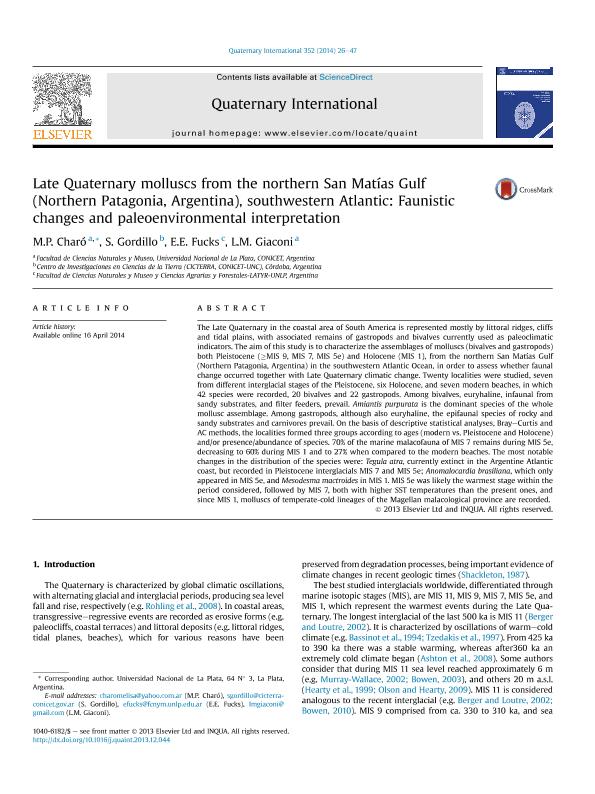Artículo
Late Quaternary molluscs from the northern San Matías Gulf (Northern Patagonia, Argentina), southwestern Atlantic: Faunistic changes and paleoenvironmental interpretation
Fecha de publicación:
03/2014
Editorial:
Pergamon-Elsevier Science Ltd
Revista:
Quaternary International
ISSN:
1040-6182
Idioma:
Inglés
Tipo de recurso:
Artículo publicado
Clasificación temática:
Resumen
The Late Quaternary in the coastal area of South America is represented mostly by littoral ridges, cliffs and tidal plains, with associated remains of gastropods and bivalves currently used as paleoclimatic indicators. The aim of this study is to characterize the assemblages of molluscs (bivalves and gastropods) both Pleistocene (≥MIS 9, MIS 7, MIS 5e) and Holocene (MIS 1), from the northern San Matías Gulf (Northern Patagonia, Argentina) in the southwestern Atlantic Ocean, in order to assess whether faunal change occurred together with Late Quaternary climatic change. Twenty localities were studied, seven from different interglacial stages of the Pleistocene, six Holocene, and seven modern beaches, in which 42 species were recorded, 20 bivalves and 22 gastropods. Among bivalves, euryhaline, infaunal from sandy substrates, and filter feeders, prevail. Amiantis purpurata is the dominant species of the whole mollusc assemblage. Among gastropods, although also euryhaline, the epifaunal species of rocky and sandy substrates and carnivores prevail. On the basis of descriptive statistical analyses, Bray-Curtis and AC methods, the localities formed three groups according to ages (modern vs. Pleistocene and Holocene) and/or presence/abundance of species. 70% of the marine malacofauna of MIS 7 remains during MIS 5e, decreasing to 60% during MIS 1 and to 27% when compared to the modern beaches. The most notable changes in the distribution of the species were: Tegula atra, currently extinct in the Argentine Atlantic coast, but recorded in Pleistocene interglacials MIS 7 and MIS 5e; Anomalocardia brasiliana, which only appeared in MIS 5e, and Mesodesma mactroides in MIS 1. MIS 5e was likely the warmest stage within the period considered, followed by MIS 7, both with higher SST temperatures than the present ones, and since MIS 1, molluscs of temperate-cold lineages of the Magellan malacological province are recorded.
Palabras clave:
Quaternary
,
Mollusck
,
Gulf of San Matias
,
Palaeoecology
Archivos asociados
Licencia
Identificadores
Colecciones
Articulos(CCT - LA PLATA)
Articulos de CTRO.CIENTIFICO TECNOL.CONICET - LA PLATA
Articulos de CTRO.CIENTIFICO TECNOL.CONICET - LA PLATA
Citación
Charo, Melisa Paola; Gordillo, Sandra; Fucks, Enrique Eduardo; Giaconi, Luis Mario; Late Quaternary molluscs from the northern San Matías Gulf (Northern Patagonia, Argentina), southwestern Atlantic: Faunistic changes and paleoenvironmental interpretation; Pergamon-Elsevier Science Ltd; Quaternary International; 352; 3-2014; 26-47
Compartir
Altmétricas




